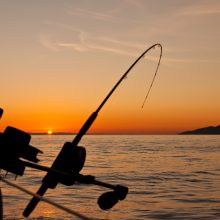This article may contain affiliate links. If you make a purchase after clicking on a link we may earn a small commission at no extra cost to you. As an Amazon Associate, I earn from qualifying purchases.
Kokanee Fishing Without Downriggers – What are the Options?

Although not the perfect setup Kokanee Fishing Without Downriggers is still possible and you have a number of available options from which to choose from.
Ideally you would be using a downrigger as it really gives you the best control and accuracy as to what depth your rig is running at.
However if none are available to you then all is not lost.
For the most part getting you lures down deeper will rely on either some form of weight or using a diver.
Both options imply that you are trolling but you can also jig for kokanee with great success if you can find them schooling on your depth finder.
Just bear in mind that modern kokanee rods are usually ultralight trolling rods due to kok’s having soft mouths so they may not be up to the task of very heavy weights.
Kokanee Fishing Without Downriggers
1. Added Weight
This will be the simplest option for a lot of people to try. Adding weight to terminal tackle is not new and you can use a very simple rig to get started.
Inline weights are the most common solution and you can use several smaller ones on your line to minimize any potential drag from one larger on.
Adding weight is a popular option when fishing for kokanee without downriggers, although it does have some drawbacks.
One of the major drawbacks of this approach is that the weight will always be on your line as there is no way to release it once you have hooked a kokanee.
Kokanee are notoriously light biters and with a lot of weight on your line you may not feel or release that they are hooked.
Another issue is that it is not a very accurate way to get your lure down to an exact depth.
2. Divers
If you have done a lot of trolling then chances are you have either used or seen some kind of diver a some point.
They are pretty simple and work on the principle of dragging your line lower in the water as the boat moves forwards through it.
- Dipsy divers
- Jet divers
- Deep Six Divers
The dipsy diver is the most common in use when trolling for kokanee without a downrigger and they are generally quite easy to setup.
A dipsy diver is basically a small plate that has your main line from the reel tied on the top and your leader tied on the back.
As you troll along forwards the diving disc dives down to a certain depth. Once a fish strikes your lure the release mechanism on the top snaps forward and the plate runs through the water without creating any downwards drag.
The also come with what os called an ‘O’ ring. An ‘O’ ring allows you to run a dipsy out at an angle from the boat on the port or starboard side.
You can run 4 divers out at varying angles without them snagging on each other assuming you are not turning in very tight circles.
3. Lead Core Line
Lead core line had gained huge popularity just after it was released onto the market and then fell out of favor.
Modern lead core is now seeing somewhat of a revival among some fresh water trolling fans. Lead core line has a different color sheath at regular intervals on the outside.
You can judge how much line you have out by what color you are on. Knowing what length of line you have out will allow you to judge the approximate depth of your lure.
You will need to use a monofilament leader of roughly 4 to 6 feet in length. Mono has some stretch in it and Kokanee have a soft mouth so it is crucial that there is some stretch somewhere in your setup.
There are a few drawbacks though and these will tend to put a lot of people off ever using it:
- Reel needs to be spooled with it
- Quite stiff and inflexible
- Very visible in the water
- Can be difficult to tie knots with
4. Troll in an ‘S’ Pattern
The slower you troll the deeper any lure(assuming it is not a floating crankbait) will go.
The main problem with slowing your trolling speed down too much is that you ca end up with little life or action in the lure that you are trolling.
However, trolling in a ‘S’ pattern can solve this somewhat as the lure will still have to move through the water.
The trick it is that the constant changing of directions mean you are not moving forward as fast as you normally would in a straight line.
This means your line and gear will sink down a bit more but the lure is still moving through the water giving it a bit more life.
5. Jigging
The best kokanee lures will usually be trolled at a slow speed but of you cannot get your boat setup for trolling then there is an other option.
Another alternative is to not troll at all and to instead jig with something like a BuzzBomb or a Revenge Spoon.
At certain times in the season Kok’s are know to school heavily. The trick to finding them is to use your fish finder to locate a school in an area that is known for having kokanee present.
Once overhead you can drop a jig straight down to them and just start jigging.
You will need to switch out your regular kokanee tackle though and use a dedicated jigging rod.
It is growing in popularity as most boats these days will have a fish finder on board.
